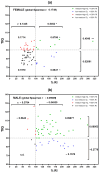Impact of Iron Intake and Reserves on Cognitive Function in Young University Students
- PMID: 39203944
- PMCID: PMC11356983
- DOI: 10.3390/nu16162808
Impact of Iron Intake and Reserves on Cognitive Function in Young University Students
Abstract
Iron is a key nutrient for cognitive function. During periods of high academic demand, brain and cognitive activity increase, potentially affecting iron intake and reserves. The present study aimed to investigate the impact of iron levels on cognitive function in a university sample, considering the influence of gender. A cross-sectional study was conducted with 132 university students (18-29 years) from the University of Castilla-La Mancha (Spain). A dietary record was formed through a questionnaire to analyze iron consumption, and blood and anthropometric parameters were measured. The Wechsler Adult Intelligence Scale-IV was used to determine the Intelligence Quotient (IQ), as well as the Verbal Comprehension Index (VCI), Working Memory Index (WMI), Processing Speed Index (PSI), and Perceptual Reasoning Index (PRI), to assess cognitive abilities. Among women, the prevalence of iron deficiency (ID) and iron deficiency anemia (IDA) was 21% and 4.2%, respectively. No ID or IDA was found in men. The impact of iron intake on IQ and cognitive abilities was mainly associated with the female population, where a positive association between iron intake, serum ferritin, and total IQ was revealed. In conclusion, low iron intake is related to poorer intellectual ability, suggesting that an iron-rich diet is necessary to maintain the academic level of university students.
Keywords: cognitive scales; dietary iron intake; female; ferritin; iron deficiency anemia; male; university students.
Conflict of interest statement
The authors declare no conflicts of interest.
Figures




Similar articles
-
Association between Haem and Non-Haem Iron Intake and Serum Ferritin in Healthy Young Women.Nutrients. 2018 Jan 12;10(1):81. doi: 10.3390/nu10010081. Nutrients. 2018. PMID: 29329258 Free PMC article.
-
Iron deficiency is associated with food insecurity in pregnant females in the United States: National Health and Nutrition Examination Survey 1999-2010.J Acad Nutr Diet. 2014 Dec;114(12):1967-73. doi: 10.1016/j.jand.2014.04.025. Epub 2014 Jun 20. J Acad Nutr Diet. 2014. PMID: 24953790
-
Prevalence of iron-deficient but non-anemic university athletes in Japan: an observational cohort study.J Int Soc Sports Nutr. 2023 Dec;20(1):2284948. doi: 10.1080/15502783.2023.2284948. Epub 2023 Nov 29. J Int Soc Sports Nutr. 2023. PMID: 38018828 Free PMC article.
-
[Review by expert group in the diagnosis and treatment of anemia in pregnant women. Federación Mexicana de Colegios de Obstetricia y Ginecología].Ginecol Obstet Mex. 2012 Sep;80(9):563-80. Ginecol Obstet Mex. 2012. PMID: 23243836 Spanish.
-
Tea consumption and iron status.Eur J Clin Nutr. 2002 May;56(5):379-86. doi: 10.1038/sj.ejcn.1601309. Eur J Clin Nutr. 2002. PMID: 12001007 Review.
Cited by
-
Mineral Homeostasis and Depression: Implications for Prevention and Therapeutic Support-A Narrative Review.Int J Mol Sci. 2025 Jul 10;26(14):6637. doi: 10.3390/ijms26146637. Int J Mol Sci. 2025. PMID: 40724885 Free PMC article. Review.
References
-
- World Health Organisation Nutrition: Iron Deficiency Anaemia. [(accessed on 20 September 2023)]. Available online: http://www.who.int/nutrition/topics/ida/en/
-
- Stevens G.A., Paciorek C.J., Flores-Urrutia M.C., Borghi E., Namaste S., Wirth J.P., Suchdev P.S., Ezzati M., Rohner F., Flaxman S.R., et al. National, regional, and global estimates of anaemia by severity in women and children for 2000-19: A pooled analysis of population-representative data. Lancet Glob. Health. 2022;10:e627–e639. doi: 10.1016/S2214-109X(22)00084-5. - DOI - PMC - PubMed
MeSH terms
Substances
LinkOut - more resources
Full Text Sources

